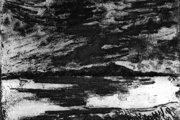Etching
|
|
Etching is an intaglio method of printmaking in which the image is incised into the surface of a metal plate using an acid. The acid eats the metal, leaving behind roughened areas, or if the surface exposed to the acid is very narrow, burning a line into the plate. Etching is also used in the manufacturing of printed circuit boards and semiconductor devices.
| Examples of etching techniques |
|---|
| Missing image Drypoint-prometheus.jpg |
| Missing image Aquatinta_landscape.jpg |
 Vernis-Mous or soft ground |
There are many ways for the printmaker to control the acid's effects. Most typically, the surface of the plate is covered in a hard, waxy ground that resists acid. The printmaker then scratches through the ground with a sharp point, exposing lines of metal that are attacked by the acid. Once the drawing in the ground is finished, the plate is submerged in acid for a period of time; longer submersion means that deeper lines are etched. The ground may be removed, or the artist may continue drawing in it, etching it again in acid to deepen existing lines while adding new lines. The ground may also be reapplied to protect existing lines while adding new ones. The ground may be removed and the plate printed to see its current printing state, to be followed by more work (or other techniques, such as aquatint, drypoint, or engraving); thus, many of Rembrandt's etchings exist in several distinct forms, with the final, "accepted" version apparently preceded by many artist's proofs.
A "soft" ground may also be used--a ground that is sensitive to pressure. The soft ground is applied to the plate, and the artist removes it by putting paper on top and drawing on the paper. The varying pressure of the pencil on the paper lifts the soft ground in a likewise varying amount, in a particulate way--rather than removing the ground, its density is decreased, allowing more or less acid through. The effect is much like that of particulate media like chalk, charcoal, or pencil: the image burned into the plate is composed of greater and lesser densities of minuscule pitting, rather than sharp, continuous lines. Minor variations involve putting a soft ground on a plate along with some textured surface (such as fabric or crumpled plastic wrap or paper), and then running the combination through a press, transferring the texture to the plate.
Aquatint is a variation in which particulate resin is evenly distributed on the plate, then heated to form a screen ground of uniform but less than perfect density. After etching, the result is a uniformly roughened (i.e., darkened) plate that may then be drawn on by smoothing it, creating the image from dark-to-light rather than the reverse.
Printing the plate is done by covering the surface with ink, then rubbing the ink off the surface with tarlatan cloth or newsprint, leaving ink in the roughened areas and lines. Damp paper is placed on the plate, and both are run through a printing press; the pressure forces the paper into contact with the ink, transferring the image (c.f., chine-collé). Unfortunately, the pressure also subtly degrades the image in the plate, smoothing the roughened areas and closing the lines; a copper plate is good for, at most, a few hundred printings of a strongly etched imaged before the degradation is considered too great by the artist. At that point, the artist can manually restore the plate by re-etching it, essentially putting ground back on and retracing her lines; alternately, plates can be electro-plated before printing with a harder metal to preserve the surface. Zinc is also used, because as a softer metal, etching times are shorter; however, that softness also leads to faster degradation of the image in the press.
Faux-bite is common in etching, and is the effect of minuscule amounts of acid leaking through the ground to create minor pitting and burning on the surface. This incidental roughening may be removed by smoothing and polishing the surface, but artists often leave faux-bite, or deliberately court it by handling the plate roughly, because it's viewed as a desirable mark of the process.
The phrase "Want to come up and see my etchings?" is a romantic cliché in which a man entices a woman to come back to his place with an offer to look at something artistic. The erotic etchings of Félicien Rops were some of the first to inspire this phrase. The connotation is that the person inviting is a suave aesthete with class and charm, unconcerned with petty matters like mere fornication; an evening with this man will be a banquet of lovemaking, if one is so inclined. A mandolin player may also be in attendance.

